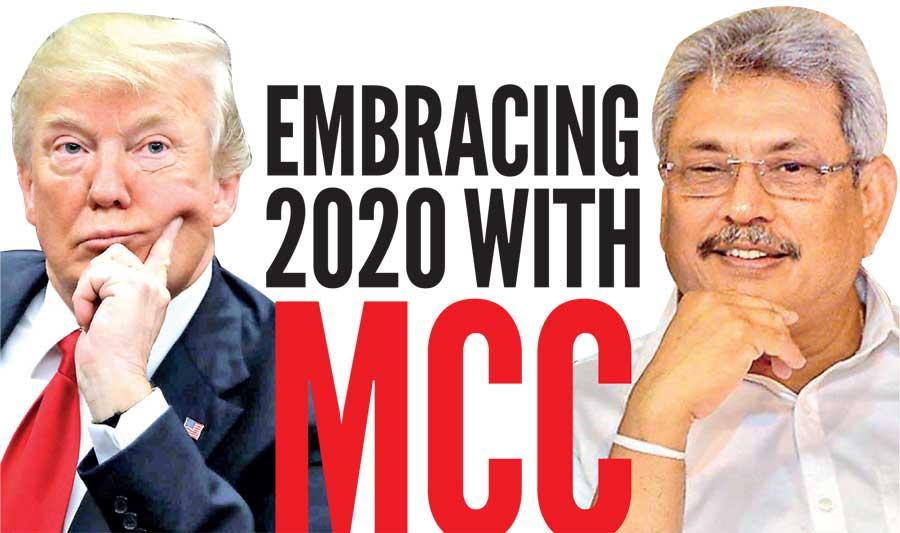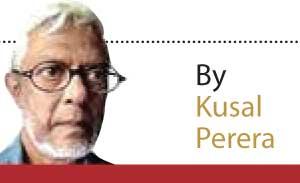Reply To:
Name - Reply Comment

There were interesting memes on the Millennium Challenge Corporation (MCC) agreement making rounds after the election. One said, when a Pohottuwa supporter was asked what MCC was, the answer had been Maliban Cream Crackers.
As it was during the 2015 presidential election campaigns when Colombo Port City was flogged with no end, the 480-million dollar MCC compact also flogged this presidential election as an American imperialist deal the WickremesingheGovernment had agreed to.Ven. Rathana Thera, Gammanpila and Weerawansa met with President Sirisena to oppose the signing of the agreement. Addressing a media briefing on November 5, Gammanpila said MCC was the most dangerous agreement Sri Lanka had ever come across. 
Immediately after the presidential election, Vasudeva Nanayakkara said he would leave the government if MCC was inked and then said President Gotabaya Rajapaksa would not sign it. Later on December 10, Gammanpila was quoted in the media as saying “70% of the MCC compact is beneficial and they are no fools to reject it, merely because it comes from America.” And the memes started making rounds. This government in a more constructive approach has appointed a four-member committee to review the compact.
Headed by Professor Lalithasiri Gunaruwan, the committee has met with PM Rajapaksa to discuss concerns over the compact and its agreement. As it now turns out, the fate of MCC would not be any different to the Hambantota Port agreement. President Gotabaya Rajapaksa has virtually accepted the Hambantota Port agreement as it is. Yet, few issues should be paid attention to, that were played out with political mischief during elections.
The social media warned about an econo-military corridor linking Colombo to Trincomalee. It was also said this special corridor would be managed by an American company and allow total exploitation of natural resources like graphite, phosphate and ilmenite found abundantly within the corridor. Implied was the message this will lead to the once speculated SOFA and free entry to US forces.
On the opposite side, there was the complete whitewashing of MCC. Free-market economists argued the MCC would provide for agricultural growth with new investments on technology and commercial farming for export markets. Potential growth in agriculture contribution to the country’s GDP that now stands at around 7% with fisheries (1.2%) and livestock (0.6%) included.
Understanding and reviewing the compact therefore need a wholly different and holistic approach beyond free-market economics and
nationalistic warnings.
"Fate of MCC will not be any different to H’tota Port agreement"
Since WWII, with the adoption of the Bretton Woods Agreement in 1944 when gold as the monetary standard was replaced by US Dollar tied to gold, the US consolidated its position as a global superpower. Dollars were pumped into countries like England, France, Germany and Japan on the Marshall Plan for their war-devastated reconstruction to open up trade and keep communism curbed. That led to the Cold War and led to their power conflicts taking hold of smaller countries like Korea, Vietnam and Afghanistan.
The CIA-backed coup in 1953 ousted the elected government of Mohammad Mosaddegh in Iran and established Shah Pallavi as the dictatorial monarch giving USA overall control of Iranian oil. In the Arab world and North Africa, the US interventions were decided on easy and cheap access to fuel reserves. In 1963, there was the failed attempt in invading Bay of Pigs in an attempt to overthrow Castro’s government in Cuba. Whatever the strategy, overt or covert, the US intervention has always prioritised US interests and foreign aid kept within that.
Thus, the MCC should be read along with Trump’s foreign policy and his “US National Security Strategy – 2017” (NSS).
Trump calls his foreign policy an America First foreign policy. In his NSS under “Pillar 11” titled “Promote American Prosperity” in the section titled “Promote free, fair and reciprocal economic relationships” where “priority actions” are listed, the first is “adopt new trade and investment agreements and modernise existing ones.”
On page 30 of NSS-2017, it reads as “The United States will pursue bilateral trade and investment agreements with countries that commit to fair and reciprocal trade and will modernise existing agreements to ensure they are consistent with those principles. Agreements must adhere to high standards in intellectual property, digital trade, agriculture, labour and the environment” (emphasis added: https://www.whitehouse.gov/wp-content/uploads/2017/12/NSS-Final-12-18-2017-0905.pdf). This is where the MCC falls in place with Trump’s NSS-2017. This emphasis in the US NSS-2017 should not be lost when reading the MCC agreement.Added is the fact that MCC is directly under the Oval Office.
The governing board of MCC is chaired by Secretary of State as its ex-officio member. The other ex-officio members of the governing board include Secretary of the Treasury who is Deputy Chair, a representative of the Trade Department and Administrator of USAID.
"The US will have India as its proxy to counter Chinese influence in the region"
The CEO and four others representing their mega private sector are appointed by the US Senate as nominated by the President. Present CEO of MCC is Sean Cairncross, former Deputy Assistant to President Trump and an advisor to the Chief of Staff of White House. That much for the independence of the MCC and where the MCC would stand on US interests.
What is also important is that Trump has expanded the previous Indian Ocean Security Concept to Indo-Pacific to include Japan and Australia in a bid to strengthen a coalition against China. For Sri Lanka what has to be recognised in this NSS is the importance India receives. The US has now established a new bilateral dialogue with India called the “2+2 meeting” between US Secretary of State and Secretary of Defence and their counterparts. The second “2+2 meeting” was held in Washington ten days ago on December 18.
During the joint media briefing after the meeting, answering a journalist, Indian Foreign Affairs Minister Dr. Jaishankar said they discussed in detail issues related to South Asia and Sri Lankatoo. That perhaps implies the US would have India as its proxy to counter Chinese influence in this region. The US has been setting about it for a few years now.
In October this year, at the time of the ninth meeting of the India-US Defence Technologies and Trade Initiative (DTTI) held in New Delhi, Pentagon announced bilateral defence trade between the two countries would reach 18 billion US dollars by year-end. Under Secretary Ms. Ellen M Lord who co-chaired the meeting told media, “US granted India Strategic Trade Authority Tier 1 status in August this year, that makes India equal to NATO allies Japan, South Korea and Australia.”
In such geopolitical context, the MCC directly controlled by Trump’s administration offers Sri Lanka 480 million US dollar “compact” with two projects. One on “land” (67 million) and the other on “transport” (350 million) with 63 million dollars for administration, research and logistics. Of the two, though the transport project is dollar-wise larger, the land project is more important. And for good market reasons. Of the total agricultural land, 63% of State-owned land is on deeds that retain “legal ownership”
with the State.
In a rural society that had not been adequately developed since independence, agriculture continues to depend on subsidies and agri-loans. There would not be paddy cultivation in Sri Lanka other than as a cultural habit if fertiliser subsidy and agri-loans were removed. Over 7 million that depend on paddy farming remain underemployed agri-labour except during the Maha season. The Census Department statistics show 83% in paddy farming during 2018/2019 Maha season were small, parcelled landholders and the majority are with untitled deeds. Another 10% are “Ande” farmers. Although all are not “Samurdi” recipients, all are poor and uprooted rural labour with no proper and regular incomes. Thus, the exodus from villages in search of a living income. Women end up as domestics in the Middle East or sweat-shop factories. Men try their hands on anything possible. All that has led to the most exploitative, labour contractors called “manpower agencies,” a very lucrative trade. This background justifies the demand to provide titles to Swarnabhoomi, Jayabhoomi and Isurubhoomi land deeds and turn them into a commodity in the market.
"Social media warn about econo-military corridor linking Colombo to Trinco"
“This project will help the government identify underutilised State land that can be put to more productive use and maximise rents from lands that the government leases. It would also increase tenure security and tradability of land for smallholders, women and firms by digitising deed records...” is how the land project is described in the project document. In a heavily pauperised agri-society left in a free-market economy, this “tradability of the land” is for “big investors” for “more productive use.”
What these big investors would turn these farmlands into will be their choice and would depend solely on profits. That can be anything from African Oil Palm cultivation to crocodile farming for leather. Transport project for improving infrastructure is only an essential component for big-time commercial farming. People will no
doubt use them.
But no government will be able to negotiate the transport project without the land project. For a government that knows only free-market economics, the land project is also a “must.”
How the Gunaruwan Committee would review the MCC agreement will be interesting. Will they propose safety clauses and on what will be an interesting discussion. The committee would take us to the New Year 2020 with MCC. I would leave the MCC discussion and the New Year 2020 to others, wishing all DM readers a New Year with good things happening as they want.